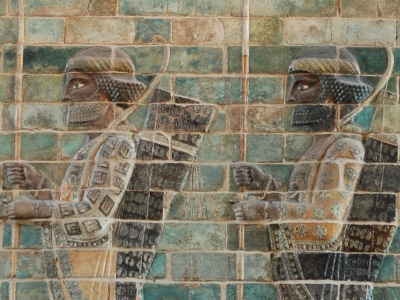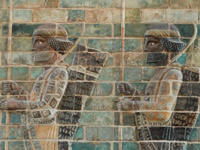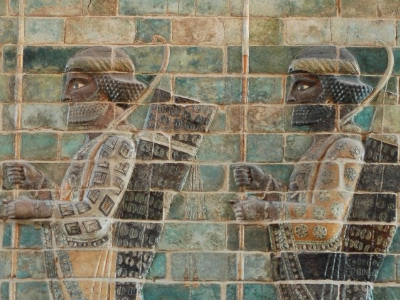Battle of Marathon (490 BC)

The Battle
The distance between the two armies at the point of battle had narrowed to "a distance not less than 8 stadia" or about 1,500 meters. Miltiades ordered the two tribes forming the center of the Greek formation, the Leontis tribe led by Themistocles and the Antiochis tribe led by Aristides, to be arranged in the depth of four ranks while the rest of the tribes at their flanks were in ranks of eight. Some modern commentators have suggested this was a deliberate ploy to encourage a double envelopment of the Persian centre. However, this suggests a level of training that the Greeks are thought not to have possessed. There is little evidence for any such tactical thinking in Greek battles until Leuctra in 371 BC. It is therefore possible that this arrangement was made, perhaps at the last moment, so that the Athenian line was as long as the Persian line, and would not therefore be outflanked.
When the Athenian line was ready, according to one source, the simple signal to advance was given by Miltiades: "At them". Herodotus implies the Athenians ran the whole distance to the Persian lines, a feat under the weight of hoplite armory generally thought to be physically impossible. More likely, they marched until they reached the limit of the archers' effectiveness, the "beaten zone" (roughly 200 meters), and then broke into a run towards their enemy. Another possibility is that they ran up to the 200 meter-mark in broken ranks, and then reformed for the march into battle from there. Herodotus suggests that this was the first time a Greek army ran into battle in this way; this was probably because it was the first time that a Greek army had faced an enemy composed primarily of missile troops. All this was evidently much to the surprise of the Persians; "... in their minds they charged the Athenians with madness which must be fatal, seeing that they were few and yet were pressing forwards at a run, having neither cavalry nor archers". Indeed, based on their previous experience of the Greeks, the Persians might be excused for this; Herodotus tells us that the Athenians at Marathon were "first to endure looking at Median dress and men wearing it, for up until then just hearing the name of the Medes caused the Hellenes to panic". Passing through the hail of arrows launched by the Persian army, protected for the most part by their armour, the Greek line finally made contact with the enemy army. The Athenian wings quickly routed the inferior Persian levies on the flanks, before turning inwards to surround the Persian centre, which had been more successful against the thin Greek centre. The battle ended when the Persian centre then broke in panic towards their ships, pursued by the Greeks. Some, unaware of the local terrain, ran towards the swamps where unknown numbers drowned. The Athenians pursued the Persians back to their ships, and managed to capture seven ships, though the majority were able to launch successfully. Herodotus recounts the story that Cynaegirus, brother of the playwright Aeschylus, who was also among the fighters, charged into the sea, grabbed one Persian trireme, and started pulling it towards shore. A member of the crew saw him, cut off his hand, and Cynaegirus died.
Herodotus records that 6,400 Persian bodies were counted on the battlefield, and it is unknown how many more perished in the swamps. He also reported that the Athenians lost 192 men and the Plataeans 11. Among the dead were the war archon Callimachus and the general Stesilaos.
HISTORY

RESOURCES
This article uses material from the Wikipedia article "Battle of Marathon (490 BC)", which is released under the Creative Commons Attribution-Share-Alike License 3.0.
© Stories Preschool. All Rights Reserved.









